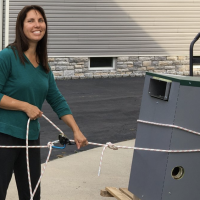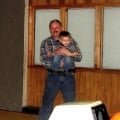Boiler size confusion
Possibly an amateurish question but here goes. Peerless ECT-03-SP
How do I determine the correct firing rate for this boiler?
The I&O manual lists the firing rate on the part number like ECT-03-SP-075 but the label does not.
Comments
-
-
-
-
Thanks Ed. The Carlin Burner had the 0.60/0.65 head position plate installed but had a .85 nozzle so I put in the 0.60 nozzle specified for the lower firing rate and checked the pump presure. Set 0 smoke -1% CO2 and its running nice. Its a small house with steam only on the first floor.
0 -
OK, now here's another amateur question. Why is it that this boiler can be downfired 50% (from 1.20 to 0.60) with apparently no problem, but our Weil McLain WGO boilers aren't "supposed" to be downfired at all (though Weil McLain did tell our oil company that it was OK to downfire them by a max of 20%, which I requested because they're so oversized to start with. I originally wanted to downfire by 50%, but our oil company said WM wouldn't approve going that low.)
This is an honest technical question. Obviously one difference is that our WM boilers are hot water, and this Peerless is a steam. Is there some internal physics difference that makes it OK to downfire a steam boiler by 50% but not OK to downfire a hot water boiler by the same amount?
0 -
It has very little to do with whether it's hot water or steam. It has a LOT to do with how the firebox and heat transfer passages are constructed. This limits both the high end (you don't want the flame to actively impinge on the firebox anywhere) and the low end (you want enough heat in the firebox from the flame to evenly heat the entire boiler). In the former case, you get soot and low efficiency. In the latter case not only efficiency suffers, but the boiler most likely will crack.
Br. Jamie, osb
Building superintendent/caretaker, 7200 sq. ft. historic house museum with dependencies in New England2 -
1.20 x.63=.756
I am a big fan of down firing and always have been. Many on here will say it can't be done or shouldn't be done. and I get drowned out. IMHO it solves a lot of issues especially if the boiler is oversized.
Back in the day I worked on a ton of coal-oil conversions and the boilers were all oversized. Old houses two families with large chimneys and draft that would take your arm off. A few fire bricks in the boiler flue to slow down the draft and a new draft regulator and a smaller nozzle with increased pump pressure to make the old clunky burners burn better.
I got news. If you down fire and your stack temp goes down (which it will) your efficiency goes up. Whats not to like??
All that is needed is a stack temp of about 325 minimum (100 over boiler water temp) the right combustion head if you down fire and some common sense. With some of the old boiler and burners you may need to do some combustion chamber work, not so much with todays equipment.
The boilers only concern is being overfired (above its rating) or underfired to much (condensation)
I suspect the MFGs are concerned with meeting efficiency guidelines and don't want to stray too much
3 -
So, should the flame ever visibly hit the target wall? I often see new boilers with good CA hitting the target wall (at least in my vision) there's a part of me that knows this isn't by the book, but the CA is good. And I have definitely had to break the rules when dealing with low draft issues.
0 -
Ed, you're my new favorite heating pro 🙂.
You may remember my first posts here two (?) years ago where I got flamed for arguing with my oil company because I wanted to downfire our WGO-5's from the 1.45 gph rating to like a 0.6 or 0.7 nozzle and they wouldn't do it. To their credit, they did call Weil McLain, who told them they would allow going down to 1.2 gph. Hardly a big change, but better than nothing.
I've also spent two years here being beaten down with posts telling me our low water temps are ruining our boilers from condensation (which is not happening). These boilers have been running cold start with low water temps for 30 years, and there's no evidence of condensation that any boiler tech can find. Between the two boilers, there's only maybe 2 pins missing in the heat exchangers after 30 years of running this way. That's it.
We have 400 degree stack temps now, so there's plenty of room to go down to 325. I'm really tempted to get a combustion analyzer this summer and try some smaller nozzles.
0 -
You could probably go down to a 1.10 or 1.00 nozzle.
I like to think of it as hitting the target wall or brushing the target wall. Brushing the target wall shouldn't be an issue. Hitting the target wall hard may be an issue. The chamber material get hot quickly and reflects heat back into the fire. This was required with older burners that didn't burn clean.
Modern burners are much better. If the flame is hitting the target wall too much you would get smoke and soot and may build carbon on the combustion chamber which is called flame impingement
But the flame hitting the target wall is usually a non issue.
2
Categories
- All Categories
- 87.3K THE MAIN WALL
- 3.2K A-C, Heat Pumps & Refrigeration
- 61 Biomass
- 429 Carbon Monoxide Awareness
- 120 Chimneys & Flues
- 2.1K Domestic Hot Water
- 5.8K Gas Heating
- 114 Geothermal
- 166 Indoor-Air Quality
- 3.7K Oil Heating
- 77 Pipe Deterioration
- 1K Plumbing
- 6.5K Radiant Heating
- 395 Solar
- 15.7K Strictly Steam
- 3.4K Thermostats and Controls
- 56 Water Quality
- 51 Industry Classes
- 50 Job Opportunities
- 18 Recall Announcements





